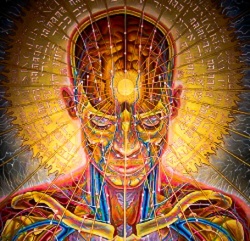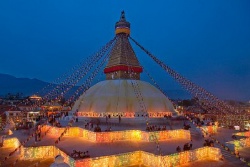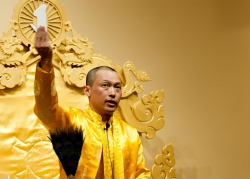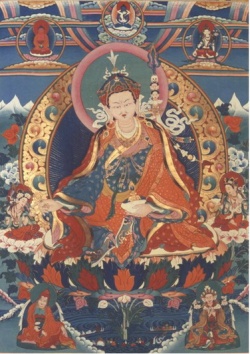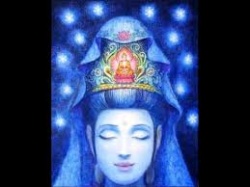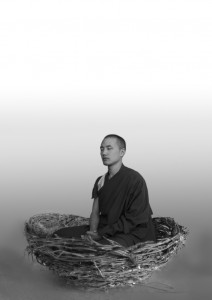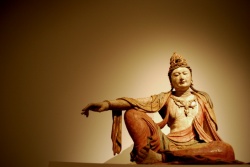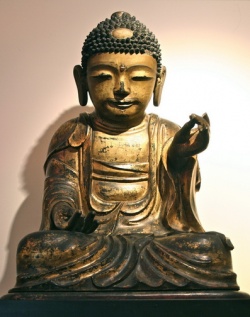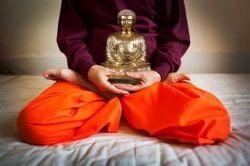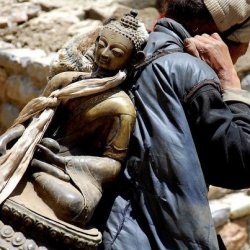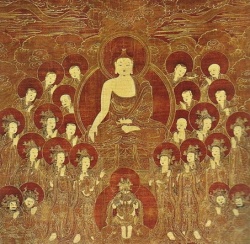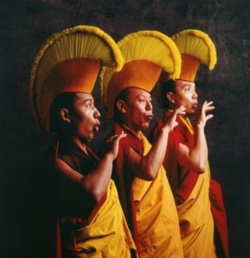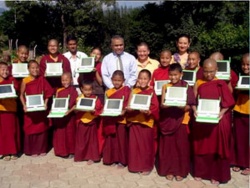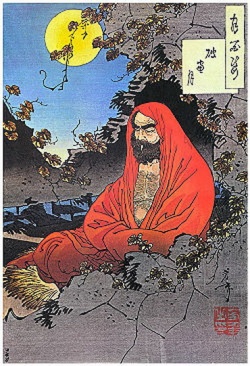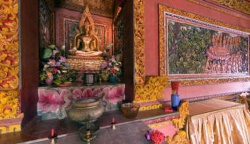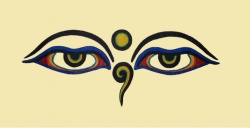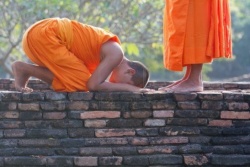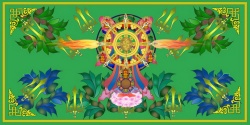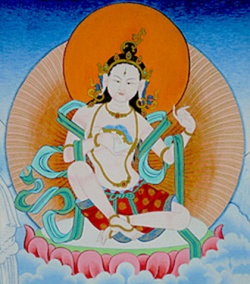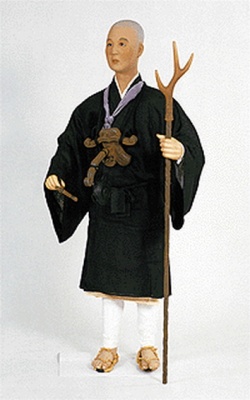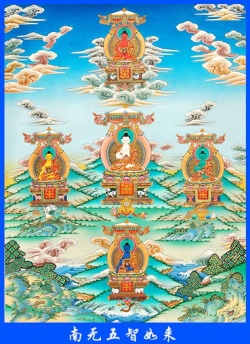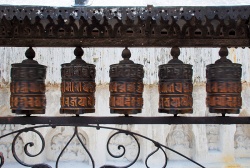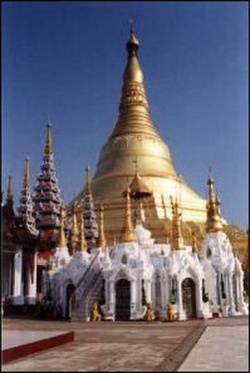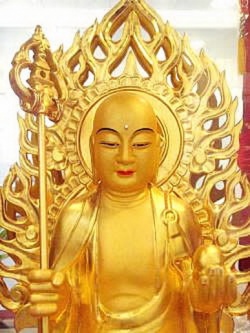Handbook for Esoteric Practitioners
By Maha Acarya Feng Da An
Preface
In preaching Buddhism, I am not concerned of not having many followers. My greatest concern is the incorrect views of practitioners, whether they are from the Exoteric School or the Esoteric School. It is indeed a great occasion that the Esoteric School has become very popular since its re-introduction to China. However, many practitioners are not practicing in accordance to the teachings, and this has created a hindrance to the preaching of Buddhism. I am writing this article in order to lead practitioners into the right track and to minimize any misconception non-practitioners may have. Dated 15th September, 1936.
Chapter One
The Exoteric School and the Esoteric School
The difference between Exoteric and Esoteric Buddhism lies in their methods of teachings. Any medicine that can cure a patient regardless of its value is a good medicine. The same is true with the way of teachings to sentient beings. As there is no such thing as superior or inferior teaching, any teaching that suits sentient beings best is the best teaching. The spiritual capacities of sentient beings are manifold. Some find the Exoteric teachings suitable while others find the Esoteric teachings more appropriate. Though it is unnecessary to discriminate the teaching against the other, it is indeed necessary to distinguish the differences between the two schools.
The word Exoteric means clear and easy. In the Exoteric School sentient beings are being taught in a step by step basis the basic doctrines in accordance to their levels of spiritual capacities, making them practice in a contented and joyous manner, thereby ending the cycle of Samsara (cycle of life and death). This is the tenet of the Exoteric School.
When sentient beings’ spiritual capacities were in pristine and ignorant state, they only had some physical desires like food and sex. With experience from many kalpas their knowledge and understandings have been enriched, their greed and desire increased, so the society they live in is no longer peaceful. They deeply feel all kinds of afflictions of human life. For those who aspire to tread the right path, they should be taught the Law of Cause and Effect in a way befitting their understanding. Right doctrines should be taught and attested by true stories of people's experiences so that they realize good deeds should be performed, bad deeds eradicated and the Five Precepts of the human realm be observed. This is the preliminary teaching of the Exoteric School.
For those who deeply believe in the Law of Cause and Effect and wish to seek heavenly felicities, they should be taught the doctrines of the Ten Goodness and encouraged to abide strictly. Further they should be taught contemplation in the Dhyana so that they can progress in the path of cultivation. For those who are tired of this mundane life and wish to be liberated, they should be taught the Twoyana teachings to sever their afflictions. This is the intermediate teaching of the Exoteric School.
For sentient beings who practice Buddhism and vow to walk the path of Bodhisattva, they should be taught the Mahayana doctrines to break off the two Discriminative Attachments (Discriminative Attachment to Ego and Discriminative Attachment to Things as Realities) and experience the first stage of Suchness (Bhutatathata). Then they should practice dedicatedly the Profound Contemplation on Emptiness of Birth to break off the Innate Attachment to Ego, and the Profound Contemplation on Emptiness of Dharma to break off the Innate Attachment to Things as Realities. Though these two teachings of the Mahayana have two aspects, one is sudden while the other is gradual; one represents phenomenon while the other represents noumenon, they should take realization of the state of Suchness as the final goal. This is the highest teaching of the Exoteric School.
The word Esoteric means profound and abstruse. The Three Mysteries of Body, Speech and Mind are the crystallization of the Buddha Virtues. Sentient beings are far below Buddha Virtues and can not understand the true meaning of the Esoteric practice. If they follow the ritual practices, they can make great achievement and on reaching the final stage of their cultivation, they can attain Dharmakaya in their physical bodies. This is the tenet of the Esoteric School.
Practitioners should receive Mantras of the Esoteric School with utmost sincerity. With dedicated practice and strong determination to reach Buddhahood, they wouldn't be disrupted by the Six Defilements, then the miraculous usage of Mantras will surface naturally; potential disasters could be avoided, and negative Karma turned favorable. Some may even develop a few supernatural powers. This is the preliminary teaching of the Esoteric School.
If practitioners can reach the state of Alaya-vijnana through their practice, they can use the power of Mantras to purify their mind, replace their bad karmic seeds with merits, transform their physical bodies into Light Forms of Heavenly Beings, prolong their lives to million billion years, fly to the heaven in their physical body forms and acquire various kinds of supernatural powers. This is the intermediate teaching of the Esoteric School.
If practitioners can reach the state of Suchness and penetrate the truth of the Original State of No Rebirth, they can rely on the power of the Three Mysteries of Body, Speech and Mind to enter Vajradhatu. Externally, they can be manifested in the form of Sambhogakaya and internally they have attained Dharmakaya. They can always maintain such wonderful state of Dharmakaya no matter they will be manifested in what forms of existence. This is the highest teaching of the Esoteric School.
Although the Exoteric School and the Esoteric School teachings are different, they should complement each other. The Buddhist scriptures of the Exoteric School are always supplemented with Mantras to speed up practitioners' cultivation. Accordingly, the Buddhist Monastic Order (Sangha) of the East Land (China) always recite Mantras like the Great Compassion Mantra in their daily liturgy. Although the Esoteric School directly awakens the Buddha virtues innate in them, if practitioners don't have sound knowledge of the doctrines of the Exoteric School or the right views, they can stray into and tread the mara-path without their awareness. This is what practitioners should be guarding against.
Chapter Two
The T'ang Dynasty Esoteric School
Many Esoteric teachings were brought to the East Land (China) before the T'ang Dynasty. these teachings were mainly preliminary and intermediate teachings and were used by Exoteric practitioners as supplementary practice. The highest teachings were not transmitted to China until the Kai Yuan period (AD 713-741) of the T'ang Dynasty (AD 618-907). Tripitaka Master Subhakarasimha transmitted the ritual practices of Garbhadhatu and Tripitaka Master Vajrabodhi transmitted the ritual practices of Vajradhatu while Tripitaka Master Amoghavajra taught the two complete ritual practices on a wide scale. With the completed highest teachings available the school was established. The school was called Mantrayana in accordance to the title of sutra texts or the Esoteric School to distinguish it from the Exoteric School. Since the school was formed in the T'ang Dynasty, it is called Tang Mi (T'ang Dynasty Esoteric School) to differentiate it from the other Esoteric teachings of preliminary and intermediate levels. These Esoteric teachings are called Za Mi (Mingled Esoteric Teachings).
Ven. Master Zhi Zhe of the Tian Tai (T'ien T'ai) School and Ven. Master Xian Shou of the Hua Yan School were two great masters of the Exoteric School. Both of them lived before the T'ang Dynasty and had not visualized that this school would be spread to China, therefore these teachings were not included as a division of their Buddhism teachings. Some Mantras were included by them in the divisions, but these were only the preliminary and intermediate teachings of Vaipulya. After the T'ang Dynasty, the great masters of this school had not spread the tenet of this school to people, thus the true face of the T’ang Dynasty Esoteric School was concealed not only to the ordinary people but also the highly enlightened ones of the Exoteric School who can't clearly distinguish it from other esoteric teachings.
The prosperity or decline of Buddhism is also affected by Karma. The T'ang Dynasty Esoteric School had ceased its propagation in China for a long time. And yet the Dharma lineage transmitted to Japan kept on flourishing, passing down generation after generation with more and more sub-branches formed. In the beginning, there were only two denominations: Dong Mi (Eastern Esoteric School, called as Shingon Shu in Japanese) and Tai Mi (Tai Esoteric School, called as Tendai in Japanese). Later, even smaller sub-branches came into existence. Due to various Karmic effects the T'ang Dynasty Esoteric School was re-introduced to China recently. The T'ang Dynasty Esoteric School which had been dormant for many years was once again had the opportunity to spread its teachings.
(The author’s note: The Eastern Esoteric School was transmitted by KoBo DaShi and was so called because the Eastern Temple (Todaiji in Japanese) was the place where the Esoteric doctrines and ritual practices were taught. The Tai Esoteric School was transmitted by Dengyo Dashi who also taught the teachings of the Tian Tai School, thus the school was called the Tai Esoteric School. In fact both of them were branches of the T'ang Dynasty Esoteric School.
After the T'ang Dynasty Esoteric School had been spread to Japan, patriarchs adopted teachings to suit the local people. Now that it has revived in China, we should use the Original Rituals of the T'ang Dynasty Esoteric School as the Orthodox Ritual Practices and supplement them with the essence of the other Esoteric teachings mentioned above to suit different spiritual capacities of sentient beings. It is indeed very good.)
Chapter Three
Veneration of Buddha
In Buddhism practitioners are particularly concerned on those who emphasize theory over practice. This is especially so in the Esoteric School that preaches the importance of putting Buddhist teachings into actual practice with veneration of Buddhas as the first step.
For those with sound knowledge of the Exoteric School they could understand the meaning of the word Buddha, but for those who begin their Esoteric Buddhism practice without much knowledge of the Exoteric School, they would have difficulty in comprehending the meaning of this word. This will be explained hereafter.
The word Buddha translated from Sanskrit means “the enlightened one". The foremost aim of Buddha is to find the true nature of sentient beings. However, the universal truth is so profound only those with deepest wisdom can apprehend. All sentient beings possess in them innate wisdom that has not been discovered due to their delusions on worldly desires and their indulgence in the Six Defilements. The so-called intelligence of mundane people is only superficial wisdom derived from consciousness. To seek for the deepest wisdom they have to banish all the mundane passions. When these worldly attachments are severed, the self-nature will surface. Those who can reach this state are the enlightened ones. From then on, they can readily deliver sentient beings and cultivate the Five Wisdoms. Once they have perfected the Five Wisdoms and their respective highest states they can comprehend the truth of the universe and there is nothing that they do not understand. This is called "completely enlightened." A completely enlightened one is called Buddha.
Buddha uses perfect wisdom and undivided compassion to deliver the sentient beings. Buddha's light will permeate within the space of deliverance, embrace and penetrate the mind of the sentient beings. If practitioners can comprehend this doctrine and practice with concentration and sincerity, over time, the light of Buddhas in their heart will become stronger. Further if they receive from the Acarya the Veneration Mantra and Mantra of Making Offerings to All Buddhas, then prostrate themselves in great respect and make offerings to all the Buddhas every day, the light of Buddhas from the ten directions will permeate with great power.
For practitioners with strong affinity with Buddhas in previous lives, they are able to visualize Buddhas’ images when paying homage. However, there are many situations where practitioners have mistaken mental illusions derived from consciousness for Substantial Material Phenomena (Se Fa in Chinese). They should be prudent and not indulged in such illusions. Even though they can see Buddha in the State of Form Composed by the Four Great Elements (Se Chen in Chinese), they should remain silence. Boasting to other people will only increase their karmic obstructions. This is what practitioners should be aware of.
(The author’s Note: Chapter Two of the Great Vaipalya Dharani Sutra quotes: "Instantaneously he sees various Buddhas. He who sees Buddas' presence should remain silence. He who sees Buddhas' presence and relates his experience will not accumulate any merit, let alone be liberated from the cycle of birth and death. He will be reborn in the three evil realms of existence and suffer from endless physical pains and mental afflictions for millions of kalpas. He will contract leprosy in this life.”
Practitioners should pay particular reference to the above-cited passage.)
Chapter Four
Repentance and Reform
Some practitioners pay homage to Buddhas according to the above-mentioned instructions for many years but still make little progress in the spiritual cultivation. This is not because they don't possess Buddha nature but because their true wisdom has been thickly veiled by delusions. When they intend to concentrate on practice, they are tempted by the Six Defilements and thus their minds are perturbed. To rid themselves of such obstructions they must resolve to have sincere and determined confession and repentance of past evil deeds. Whenever temptations arise, they must fight them resolutely. One who can perform such act is a real reformer. If they can receive Mantras from Acaryas to recollect the mind, the effect will be even greater. Some practitioners recite the Repentance Mantra, but their mind is still tempted by delusions as before. This can not be considered as real repentance.
Sentient beings have so many delusive deeds that it is difficult to account for each of them individually. Repentance can be classified into two categories.
One: Ordinary Evil Deeds -- divided into three sub-categories.
A. Evil Actions: 1. Killing 2. Stealing 3. Adultery
B. Evil Speech: 1. Telling lies 2. Speaking words that distort facts 3. Speaking abusively 4. Speaking as if with two tongues.
C. Evil Thoughts: 1. Greed. 2. Hatred. 3. Perverted Views
Two: Special Evil Deeds--divided into two sub-categories:
A. Five Deadly Sins: 1. Killing parents 2. Killing Arhant 3. Causing blood to flow from Buddha's body 4. Creating discord to Buddhist Sangha 5. Defaming the Triple Gems
B. Evil Deeds On Drinks and Foods: 1. Smoking 2. Consuming Alcoholic Drinks
3. Eating meat and the five forbidden pungent roots
The Exoteric School has detailed explanations of the above-mentioned evil deeds, so they will not be dealt with in this handbook. The Esoteric School also finds it necessary for practitioners to repent on the above-mentioned evil deeds one by one in order to get rid of delusions in order to realize their true nature. Except for the Five Deadly Sins that practitioners may not have committed in this life, other evil deeds are inevitable. Therefore, they must always be on guard against such evil deeds. Practitioners will not be able to get rid of their karmic obstructions by mere confession and repentance. They should be determined not to commit the evil deeds again. Those who can not cease committing all of them at once should do so gradually.
The above-mentioned method of confession can be found in Bodhicitta Sila Sadhana translated by Tripitaka Master Amoghavajra. The same method can be found in The Tenet of Dhyana written by Tripitaka Master Subhakarasimha. So these are the Orthodox Sadhana of the Esoteric School. The longer the practice the greater the effect will be. Practitioners that merely go through the motion of confessing can hardly discover their Buddha-nature.
Some people may inquire whether Esoteric practitioners must cease taking alcoholic drinks and meat. In all the Sutras of the Esoteric School, they emphasize the importance of changing such food habits.
Some may inquire of the situation of not being able to take vegetarian food due to various circumstances. As long as this person has no intention of harming lives or indulging in the taste of meat, eating meat will not be a big obstruction to their practice. However, for a person who lives in an environment where he can take vegetarian food but is reluctant to give up taking meat, he is bound by mundane desires and no matter how diligent he practices, he can hardly accomplish his goal. He may have some small efficacy occasionally as a result of either corresponding to meat-taking ghosts and spirits mistakenly or to the External Vajra Group. Practitioners with higher aspirations should contemplate on it.
Some may ask why it is that only Cundi Ritual allows the laity to take alcoholic drinks and meat. "Keeping the Sila (precepts) pure" is clearly written in the first part of the ritual. But in order to deliver all sentient beings, this expedient Dharma-door is established as a solution to a confined environment. Naturally, the effect of practice wouldn't be as great as the effect of keeping the precepts pure. Therefore, practitioners who determine to accomplish higher goals should not be satisfied with small effects unless there is no alternative.
Chapter Five
Bodhicitta Sila
As in the Esoteric School paying homage to Buddha and repenting one's evil deeds are also the preliminary practice of the Exoteric School. In accordance to their spiritual capacities, practitioners are either given hundreds of Bhikkhu Precepts (Sila) of the Hinayana tradition to cope with various kinds of defilements or dozens of Bodhisattva Precepts of the Mahayana School to develop their acts and vows. The Bhikkhu precepts are for the Bhikkhus to observe while the Bodhisattva Precepts are for the Bhikkhuas as well as the laity to observe.
The basic essence of the Bodhisattva Sila is to develop the practitioners' Bodhicitta (Mind of Enlightenment). When the practitioners have attained emptiness in the Five Sklandhas (aggregates), the profound meaning of Bodhi will reveal itself. Once they have attained this state of mind, their compassionate acts are all for the deliverance of sentient beings. For practitioners who could comprehend and realize the highest teachings of the Exoteric School, they've developed Profound Bodhicitta. From then on, their acts are in accordance with the precepts of Bodhisattva Sila, and if they can maintain this state of Mind of Enlightenment, they are observing the Profound Bodhicitta Sila.
As practitioners are deeply attached to mundane desires and thus their Bodhicitta is veiled, they must rely on a patriarch (one who has become enlightened in the Mahayana School) to help them find their true nature. Although they haven't yet realized the self-nature innate in them, and if they observe and act without violations of the Bodhisattva precepts they can be considered as observing the Bodhicitta Sila of Acts and Vows.
The degrees of conception of these two types of Silas are different but both can make practitioners realize the tranquil and un-divided state of Suchness. Although mundane desires are eliminated, Buddha wisdom has not yet surfaced, the accomplishment they have attained is still that of the Exoteric School. Further more there is the Samadhi Bodhicitta Sila which is unique to the Esoteric School.
For practitioners observing the Samadhi Bodhicitta Sila, Maha Acaryas of the Esoteric School will introduce them the Great Mirror Wisdom Seed and bless them with the power of the Three Mysteries. As soon as the seed matures, self-nature will be revealed as if in the form of a full moon. This phenomenon is actually formed by the power of Samaya, so it is called Samadhi. It is with the power of Great Mirror Wisdom that the Buddha will perceive the enlightened ones and sentient beings of the ten directions. Only those who have attained this state of accomplishment can be said to have entered the state of Buddha, and it is also called Samaya Leading to Buddhahood.
Since the principal objective of the Esoteric School is to bring forth the Great Mirror Wisdom, the Bodhicitta Sila received by practitioners is uniquely named as Samaya Sila or Passionless Purity Dharma Sila Internally Attained by Buddhas. Although Esoteric practitioners also observe the Bodhisattva Sila of the Exoteric School, the main objective of these two schools is different. This is the unique characteristic of the T'ang Dynasty Esoteric School.
The Samaya Sila is the Ultimate Sila of all Silas. Practitioners who have received and observed this Sila strictly can reach Buddhahood; they are beyond the state of Twoyana. Therefore practitioners who are willing to receive this Sila do not have to observe the Silas of Hinayana. Those who have changed mid-way their path of practice to Hinayana are because either they haven't been instructed by an enlightened master or their spiritual capacities are not suitable to practice the T'ang Dynasty Esoteric School.
Chapter Six
Abhisecana (Initiation)
If practitioners receive the Samaya Sila with utmost sincerity, the Seed of Enlightenment will be planted in their minds naturally forever. If they practice the Moon Disc Contemplation diligently, the Great Mirror Wisdom will develop and consolidate gradually. Once they reach the state of Samadhi, they can correspond to the great powers of Buddhas of the ten directions. But their experience is only that of the Equality of Seed Nature of various Buddhas radiating over the whole Dharmadhutu. They haven't realized the wonderful form and the real sublime state of any Buddha. Therefore, it is necessary that they receive Abhisecana.
A practitioner has to choose from many Buddhas the one he wishes to devote himself to. Then he prays for the meritorious water empowered by the Chief Deity to be sprinkled over his head and penetrate his mind so that it becomes the Seed of Enlightenment. With the power of the Three Mysteries and with dedicated practice the Seed of Enlightenment will develop and their self-nature will be revealed. They are now in the same state of Samadhi as the Chief Deity, and wherever their existence and whatever they, the wonderful form of the Chief Deity will manifest itself. This is the wonderful achievement of receiving Abhisecana.
Practitioners don't have the ability to ask for Abhisecana from Buddhas unless they have reached the deep and completely tranquil and undivided state. Therefore, they must rely on an Acarya to perform the empowerment. In choosing the Chief Deity a practitioner must act resiliently and appropriately. He can determine his choice either by plunging flowers (onto a mandala) or by his own cherished wish. Once the Chief Deity has been decided the Acarya will enter the Samadhi of the Chief Deity for empowerment and perform rituals in the altar. Offerings like water, incense powder for smearing one's hands and body, flowers and incense for burning will be blessed. The higher the Acarya's accomplishment in practice, the greater his blessing power will be. At the same time, the practitioner is also immersed in the vast deep ocean of Dharmadhatu. The formless Buddhas' merits penetrate into his mind continuously from the top of his head though he may not be able to feel it, as his mind is obscured by worldly delusions. To improve the practitioner's perception, the Acarya will sprinkle meritorious water over the head of the practitioner. If the practitioner with utmost sincerity visualizes the blessed water passing through the top of his head to the mind, the seed of the Chief Deity planted in his mind will flourish. Then the Acarya will confer the Three Mysteries of the Chief Deity upon the practitioner who must receive them with utmost piety so as to achieve success quickly.
No matter which Chief Deity a practitioner chooses and how hard he practices, there will be no result unless he has received empowerment from Acaryas. It is like planting flowers. If he has not planted the seeds and merely hopes for the flowers to grow, there will be no flowers.
Since initiation is important to the growth of the Seed of Enlightenment, one has to be prudent in choosing his Guru (Acarya). The life force of the Seed of Enlightenment is in proportion to the power of the Acarya. For practitioners with exceptional spiritual capacities who had received powerful initiation and had reached a high stage of practice in previous lives, though such knowledge and experience have been concealed by rebirth, if such practitioners have the chance of receiving the Esoteric School Abhisecana, the merits accumulated over previous lives will be revived. For practitioners who can achieve quick success in the path of cultivation, initiation from ordinary Acaryas will work equally well.
Chapter Seven
Sanskrit
The T'ang Dynasty Esoteric School was originally named the Mantra School. The meaning of Mantra has to be explained here. The vibrational force of Dharmadhatu when interacting with different objects will produce the appropriate natural sounds. When the bell and drum are struck, they make the sounds of gong and boon respectively. The two sounds are pure natural sounds. As for human beings, when they laugh, their laughter is hahaha. When they cry, their crying is boo-hoo. These two are also pure sounds. The mouth because of its special position will produce different pure sounds, thus, representing different aspects and states in Dharmadhatu. The throat, palate, gums, teeth, lips, tongue and nose interact with one another, and they represent various external symbols of Dharmadhatu. The language of Buddha is the sounds of Dharmadhatu, and they are all pure, so they are called the True Language. Originally the sounds of human beings were also pure. However, with the development of society and sophisticated social interaction, names were invented or adopted, the language gradually lost its natural symbols and has become the False Language (Language of mankind in comparison to Buddha's True Language)
When Buddha Shakyamuni preached Buddhism to people in India, he also had to rely on False Language. But once he started to speak the Esoteric Mantra, he would revert to the True language. As Mantras flow out of Buddha's Repository of Merits, no False Language can represent them. The phonetic sounds of Indians at that time were complete, so the words recorded in Vernacular Sanskrit transcribing system were similar to Buddha's True Language. However, when they were spread to other places, the sounds become distorted due to the incomplete phonetic sound systems of those areas. Therefore, one has to study Sanskrit to learn the Mantras.
Sanskrit consists of 16 vowels and 33 consonants. The vowels can be divided into simple vowels and diphthongs. They are subdivided into long simple vowels, short simple vowels, simple diphthongs and complex diphthongs. The consonants are composed of five groups of stops and nasals, voiced and unvoiced aspirates, sibilants and semi-vowels. Besides, there are also rules to combine the sounds. When practitioners recite Mantras using such sound system that is similar to the True language, they are achieving much greater effects than those who recite Mantras with the translated sounds. In various Buddhism texts there are different views on Sanskrit. How can one distinguish the translated sounds from the original sounds in Sanskrit? In the book A Record of Siddham Sound there are detailed examples of sound combination, but it lacks detailed explanations of the principles of vowels and consonants, thus, it is still difficult for practitioners to determine the standard sounds. European scholars who studied Sanskrit have published books with clearer expression. Recently English, French, German and Japanese versions become available. Practitioners can use them as reference.
In all the sutras of the Esoteric School, inaccurate pronunciation is of grave concern as it will affect the effect of Mantras. Some may wonder why in China a practitioner reciting the Six Syllable Mantra mispronounced the sound "Hum" as "Niu" could still achieve result, but the effect was lost when one kind-hearted practitioner corrected his pronunciation. The reason is that when this practitioner was converted to Buddhism and started to venerate Buddha, he used the Six Syllable Mantra as a means to recollect his mind and this achievement was not the special effect of the Six Syllable Mantra. He had doubt trying to correct the pronunciation later on. It was this doubt that had prevented him from further advancement. Some people practice by reciting the Great Compassion Mantra without receiving initiation. Their pronunciations are not accurate, and yet they have some achievement. This is the effect of concentration as their minds are not scattered.
Chapter Eight
The Moon Disc Contemplation
The T'ang Dynasty Esoteric School takes the realization of Samadhi Bodhicitta as the foundation for further advancement. It is on realization of such state that practitioners can see the true, sublime and wonderful forms of Buddhas. Otherwise, these forms are only illusive images arising from the interaction of their mind (seeds in Alaya Vijnana) with external conditions. Therefore, it would be better for practitioners who have received Bodhicitta Sila and initiation to practice the Samadhi ritual. The Samadhi ritual is also called the Moon Disc Contemplation.
For practitioners who have reached the highest state of the Exoteric School and attained the emptiness of the five Sklandhas, they can achieve realization in the Moon Disc Contemplation very quickly. Practitioners with such spiritual capacities will not be discussed here. It is the common way for practitioners to achieve the Moon Disc Contemplation that will be introduced.
To do this practice, the practitioner must be in a quiet room alone, the mind free of all mundane cares, seated in lotus posture (The author’s note: Full-lotus posture recommended, otherwise, in half-lotus position) and practicing the Mudras and Mantras transmitted by his Guru. Then using a rosary he recites the Mantra for at least 108 times. After this is done, he should prostrate himself in front of Buddhas and make offerings from his mind as required by the ritual. At the same time, he must confess and repent all his past evil deeds and makes great vows. Then he can proceed to practice the Moon Disc Contemplation.
He starts the Moon Disc Contemplation with the practice of mind concentration. However, the mind is so easily distracted that he should practice breathing to regulate the breath so that it can correspond to the state of Bodhicitta. When Bodhicitta is present in the mind, it will expand gradually, from centimeters to meters and even to infinity. Eventually it will settle to the size of one elbow (approximately 8 Cun in Chinese measurement or 0.27m) as a bright and clear moon disc. When one succeeds in this contemplation, he has attained the Moon Disc Samadhi.
There are some practitioners whose mind can not correspond to the Mind of Enlightenment even after their breath has been regulated. For such practitioners they should visualize in front of them a bright and pure moon with the diameter of one elbow and is in four elbows' distance from their bodies; their eyes slightly opened. In the beginning, they may not be able to see anything, but gradually the form of the moon will appear. After they can see the form clearly, they should extend it to infinity and then gather it into their mind.
The word Moon Disc is used to describe the achievement in the practitioner's meditation. Actually, there is no such real object as a beautiful moon of the universe in front of the practitioner. After the practitioner has achieved such contemplation regularly, the moon disc will not surface. All he can feel is complete tranquility and brightness permeating through the whole Dharmadhatu. There will be no physical body, no mind and no phenomena. Even there is no idea of transcendence. As all vexations have vanished, there is nothing to deal with. He has attained the Wisdom of the Embodied Nature of Dharmadhatu (Dharmadhatu-prakriti-jinana). When he has reached this state, he corresponds to the nature of Vairocana Buddha.
The highest state a Ch'an practitioner can reach is the same as the state described above. Those with slightly inferior spiritual capacities can attain the State of No Birth and are free from the bondage of attachments; yet there still exists what seems to be a thin layer of mist separating them from the state of complete tranquility and brightness of Dharmadhatu.
Chapter Nine
To Become Buddha in This Present Physical Body
To Become Buddhas in This Present Physical Body means that practitioners can attain in their present physical bodies the various Dharmakayas of Buddha. This doctrine is not discussed in the Triyana teachings. In Oneyana, there is the doctrine of "directly reaching Buddhahood". But it is not explained in details. There are three stages in attaining the state of Becoming Buddha in This Present Physical Body.
(1) To Become Buddha in This Present Physical Body in the Dharmadhatu of Bhutatathata.
When the Six Defilements are eliminated together with their internal Six Sense Organs, ignorance has been overcome in the most direct way. Brightness will permeate the universe. Once the practitioner has attained this state of awareness whatever he does will conform to the true nature of Dharmadhatu. Only when he reaches this stage of practice can he merge in unity with the Dharmadhatu of Bhutatathata. Though his physical body is no different from others', his self-nature is the same with Buddha. The great masters of the Ch'an School can attain this state, calling it the Innocence Buddhahood of Self-nature. All phenomena in Dharmadhatu are arising from causes and conditions. If a practitioner had not attained a high stage of practice in his previous lives, he cannot immediately reach this true state in this present life. If he can see the wonderful form of a Buddha in Samadhi, he must have paid homage and made various kinds of offerings to this Buddha in his previous lives. The Esoteric School takes this state as the foundation for advancement to the two higher states described hereinafter.
(2) To Become Buddha in This Present Physical Body in the Lotus Dharmadhatu (Garbhadhatu)
In Dharmadhatu of Bhutatathata practitioners rely on their All-discerning Wisdom to activate and develop various Buddhas’ Energy. If he can obtain the seed of Buddhas' Dharma-nature by practicing rituals and moistening it with the power of Mantra, the seed will grow gradually and turn into the lotus Dharma-realm. Eventually, the self-nature of the Chief Deity of Devotion will manifest itself in his body. All his body will be permeated with Buddha's Energy and become the Chief Deity in Nisyanda Dharmakaya. The Buddha-nature is then manifested as Sambhogakaya, dashing out from the crown of the practitioner and as Dharmakaya in Its Power of Transmutation rushing out from his pores. For the ordinary people they can only see the practitioner sitting in lotus posture in Samadhi, but for people whose eyes are extremely pure they can see the practitioner's body radiating. Those having strong affinity with the Chief Deity in their previous lives can see auspicious forms of Buddhas in the radiance.
(3) To Become Buddha in This Present Physical Body in the Vajra Dharmadhatu
In the Lotus Dharmadhatu the Chief Deities can manifest themselves in various Dharmakayas, but the Body of Self-nature has not been fully developed. Therefore, the practitioner has to attain the realization of the Great Powerful Mind with Perfect Mirror Wisdom. Then the Dharmakayas of Buddhas of ten directions will reveal themselves clearly, permeating into the practitioners' bodies in the forms of Sambhogakaya and interacting with Nisyandakayas. Only when he reaches this stage can he correspond to Vajradhatu. Then he will return to the Lotus Dharma-realm. The Chief Deity's Sambhogakaya and various Dharmakayas in Their Power of Transmutation are especially delicate, bright, pure and sublime. Only after a practitioner has attained this stage can he Become Buddha in This Present Physical Body with perfection in the real sense.
Dharmakaya originally has no form. Since it is achieved in the Dharmadhatu of Bhutatathata, it merges in unity and in total equality. Although the Five Great Elements appear and interact with one another in the Lotus Dharmadhatu and Vajra Dharmadhatu, they have different characteristics. When the practitioner uses his Wisdom Derived From Self-nature to interact with the Five Great Elements, the interaction will realize into the wonderful and sublime forms of Buddha. The Five Great Elements is being referred to as the characteristics of solidity (earth), moisture (water), brightness and warmth (fire), movement (wind) and void as shown by self-nature without obstruction (space). Wisdom Derived from Self-nature refers to Vijnanamatra as described in the Dharmalakasana School. In the Esoteric School the Dharmakaya is manifested in form and color from the Six Great Elements. Such doctrine is really profound. It is through actual practice and realization that a practitioner will be able to appreciate the Esoteric meaning of this wonderful doctrine. When discussing in words we can only know the theory. Exoteric practitioners always take the sublime Nirmanakaya (physical body) attained after many kalpas' cultivation as the sign of reaching Buddhahood. So they would have doubts on the above-mentioned profound doctrine. According to the Esoteric School, such Nirmanakaya arises from the Form Composed by the Four Great Elements (Se Chen in Chinese), and is different from the wonderful Dharmakaya derived from the Causal Origination of the Six Great Elements. If the practitioner hasn't reached such state, he should be prudent enough not to make wrong comments on this doctrine. Otherwise, he might commit the evil of slandering Dharma.
Chapter Ten
Acarya
Acarya is a Sanskrit word. It means instructor. Both the Exoteric School and the Esoteric School regard a person as the Acarya of its school if he can fully understand the doctrines of the Dharma-door he preaches, has reached the highest stage of its practice and is qualified to instruct other practitioners. Therefore, this name is especially popular in the Esoteric School.
The main goal of an Acarya of the Esoteric School is to guide practitioners to reach Buddhahood in this present physical body. The Acarya helps practitioners to advance step by step in the path of cultivation by requiring them to repent their evil deeds, giving them precepts and empowerment. However, the Acarya has to possess two kinds of qualities in order that practitioners can benefit.
(A) He has reached the highest stage of practice of the school.
Only when an Acarya can correspond respectively to the three Dharmadhatus mentioned in the last chapter that he will be considered to have attained the highest state of the school. If he doesn't correspond to the Dharmadhatu of Bhutatathata, he lacks the basic quality required of an Acarya. If he doesn't correspond to Lotus Dharmadhatu, he can't give initiation of Garbhadhatu. Likewise, he cannot give initiation of Vajradhatu if he doesn't correspond to Vajra Dharmadhatu. However, if he performs rituals according to its process and requirements, he can help those with good practice in their previous lives by reviving the Buddha-seeds in their mind.
(B) He has fully grasped the essence of the doctrines of the school.
An Acarya is in the position of delivering sentient beings, so he has to use expedient methods to guide practitioners. Besides having deep understanding of the wonderful doctrines of the Esoteric School, he has to study the various doctrines of the Exoteric School carefully. If he doesn't master the teachings of the Exoteric School, he can't show practitioners the special characteristics of the Esoteric School. He may not be able to differentiate the preliminary state from high state and instruct the students with the appropriate practice.
In addition to the two qualities mentioned above, an Acarya should also possess other virtues. Practitioners can refer to the Chapter on Conditions from the Mahavairocana Sutra and the Chapter on Judging Acaryas from the Susiddhikara Sutra for details.
Oneyana teachings directly reveal Buddha nature. There is no distinction as to whether the Acarya should be a lay person or a Bhikkhu. When the Acarya realizes the deepest essence, he can penetrate the truth of the universe naturally. However, in Triyana teachings, some people's thinking is confined by teachings which don't reveal the whole truth of Buddhism and think that lay people cannot become Acaryas of the Esoteric School. In the Susiddhikara Sutra and Commentary on the Mahavairocana Sutra there are explanations to resolve people's doubts. However, the doctrines are too complicated for beginners to understand. Only the Delicate And Wonderful Maha Mandala Sutra has explained the doctrines clearly and concisely. The main ideas of this sutra are summed up hereafter.
1. Whether an Acarya accomplished in the practice of rituals of the Vajradhatu is a Bhikkhu or Upasaka, he should keep himself away from the Five Evils (i.e. killing, stealing, committing adultery, lying, taking alcoholic drinks), deeply believe and dedicatedly practice the Three Mysteries of Body, Speech and Mind. Relying on the wisdom and expediency derived from Samadhi, he should instruct sentient beings in order to make them understand and believe in Buddhism.
2. If a Bhikkhu or layman practices the Esoteric School as Acarya and can help all sentient beings aspire to achieve perfect enlightenment, the four categories of Buddhist disciples should respect, revere and make offerings to him as if they were doing so to the Buddhas.
3. For Acarya and practitioners who observe the Bodhisattva Sila or the Bhikkhu Sila, they should refrain from doing evil deeds. For those who only observes Bodhisattva Sila, they do not have to banish traditional ethics of husband and wife relationship, but they should not indulge themselves in mundane passions. In this way, they can attain wisdom derived from Samadhi and benefit sentient beings.
Upasaka or layman mentioned above or those who only keep Bodhisattva Sila are all referred to the laity. One quotation from the Sutra can well explain the fact that both Bhikkhus and the laity can be Acaryas, not to mention two or more quotations.
The Delicate and Wonderful Maha Mandala Sutra warns Acaryas against taking of alcoholic drinks and meat. The following is a quotation of the conversation between Vajrapani Bodhisattva and Buddha.
Vajrapani Bodhisattva asked: "If an Acarya indulges himself in practicing worldly things, if he constantly seeks for worldly pleasures, and if he takes wine, meat and the five pungent roots, how can he guide his disciples to the altar and liberate them from the suffering of death and rebirth? How can he make them acquire the highest stage of practice of Mantra? I'm now puzzled. How should I view their actions?" Buddha answered: "There is definitely no such Acarya who is attached to worldly fame and gains, who constantly seeks for worldly pleasures and who enjoys taking wine, meat and the five pungent roots."
From this conversation, practitioners can draw the conclusion that if a person indulges himself in worldly pleasures and in taking wine and meat, even though he is called an Acarya and guides people to the altar, both he and the students can't accomplish the highest stage of Mantra practice. They can't be freed from the cycle of life and death.
Practitioners may wonder how to distinguish such Acaryas from incarnations of Buddhas and Bodhisattvas who sometimes come out of the Samadhi of Perfect Freedom or the Playful Samadhi(they are free from any attachment or bondage and they can manifest themselves in any form or manner as they wish as if they were playing) and deliberately drink wine and take meat. The answer is that the real reincarnations of Buddhas or Bodhisattvas can take alkali and various dirty things without the slightest discomfort or trouble and for the others the act of drinking wine and taking meat are arising from deep-rooted habits. It should not confused with the acts of reincarnations of Buddhas and Bodhisattvas.
Chapter Eleven
Recitation of Mantra Recitation is an important step in the practice of the Esoteric School. It requires clear elucidation. The recitation method of the Vajradhatu is so subtle and complicated that it is difficult for novice practitioners to grasp. So this method will not be discussed in this handbook. What will be expounded on is the recitation method of the Lotus Dharmadhatu.
If a practitioner is repenting his past evils deeds, observing the Bodhicitta Sila, has received initiation of Garbhadhatu in the altar, has received Mantra and Mudra from his Guru, trying his best to make the Bodhimandala sublimed, making offerings to the Chief Deity, practicing Mantra as required by the ritual every day and has recited 100,000 times of the Mantra in ordinary procedure, he can break off the first stage of Attachment to False Views and correspond to the Nirmanakaya of the Chief Deity. After 200,000 times of recitation, he can break off the second stage of Attachment to False Views and realize the Sambhogakaya of the Chief Deity. If he has recited the Mantra for 300,000 times, he can break off the third stage of Attachment to False Views and attain the Dharmakaya of the Chief Deity. If a practitioner has corresponded to the Dharmadhatu of Bhutatathata before he receives initiation, he can accomplish the goal with fewer times as 300,000 times of recitation. If a practitioner has lower spiritual capacity, is unable to make offerings or prostrations to Buddhas or is kept busy by mundane cares, as long as he can remember to recite the Mantras and do it at the fixed time every day, he can break off the first stage of Attachment to False Views after 1,000,000 or even 3,000,000 or 4,000,000 times. Depending on the spiritual capacity of the practitioner, he can break off either the second stage or the third stage after he has completed 10,000,000 times. If he intends to count the number to see how he is achieving his goal, he has to keep the following precepts besides observing the Bodhicitta Sila.
1. He should try his best to perform the Ten Goodness.
2. He should try his best to rectify such bad habits as drinking wine and taking meat and the five forbidden pungent roots.
3. He should concentrate his mind on the Mantra and not to be distracted by other things.
4. He should pronounce each syllable of the Mantra accurately and shouldn't use similar sound to replace it.
5. He shouldn't count the recitation as one time if he has to spit or cough in the course of recitation.
6. He shouldn't recite the Mantra with a voice that is too slow, too quick, too loud or too low. He shouldn't talk to other people at the same time either.
7. He should be single-minded in reciting the Mantra of the Chief Deity. He shouldn't recite the Mantras of other deities before he breaks off Attachment to False Views.
8. He shouldn't teach others the Mantras he has received from his Acarya.
9. He shouldn't be arrogant. He should always be kind and compassionate.
10. He who is determined to reach great accomplishment shouldn't perform exorcism and help others rid themselves of misfortunes and disasters.
The above ten precepts are summarized from the tenets of Susiddhikara Sutra and Subahu Sutra for practitioner's reference. If he can keep all these precepts, it's not difficult to accomplish his goal. If his action is contrary to one or two precepts mentioned above, his achievement will be small. If he breaks most of them, he can't expect to be successful in the cultivation of the mind.
Chapter Twelve
How to Distinguish States
(Internal Realizations)
If a practitioner recites Mantras properly as required by rituals at the fixed time every day, gradually he can attain certain states. However, he has to distinguish the real states from mental illusions.
People in this world are tempted by the Six Defilements, so their seeing capacity and hearing capacity are greatly veiled by delusions. In the human form of existence, what they can see is confined to whatever is within the reach of their eyes. They can't make out far away objects, let alone see other forms of existence. Human beings don't possess many good virtues. The good seeds of the Devas can't manifest themselves in their minds but the evil seeds of ghosts can easily appear in their minds without their awareness. If they banish mundane cares with the intention of developing spiritual cultivation, their minds become tranquil, so images of ghosts would take this opportunity to appear. Practitioners of other religions have attached great importance to such phenomena, thinking that they've made great achievement. Buddhist practitioners with the right view will ignore such phenomena. They are afraid that if such phenomenon appears frequently, the evil seeds of ghosts will permeate into their mind and may lead them to the ghost realm upon death. Becoming Buddha is the goal of the Esoteric School. Esoteric practitioners should abandon the state of heavenly place and ignore images of ghosts. This is the first point practitioners should keep in mind.
When practitioners are in the beginning stage of practice, their worldly passions are still rampant. Therefore, it is difficult for them to see the Chief Deity through Comparison and Inference. Some practitioners' mental state might be affected by their practice in the previous lives. When it interacts with consciousness, it is transformed into the State of Form Composed by the Four Great Elements with images of Buddhas and Bodhisattvas appearing. This is called the State of Single Image (Du Ying Jing in Chinese). Evil seeds still exist in their minds. If they cannot penetrate the truth at once with the All-discerning Wisdom, it will change into mental illusions manifested in the forms of Buddhas and Bodhisattvas. This state is called State with Substance (Dai Zhi Jing in Chinese). Both these two states are unreal. If practitioners are attached to them, they will go astray from the right path of cultivation to heretic practices. This is the second point that practitioners should bear in mind.
If practitioners can concentrate their minds on the Mantra in the course of reciting it, the seed of the Chief Deity will reveal itself; thus they can see the auspicious image. If this form corresponds to that of the Chief Deity and it is accompanied with various kinds of light, it is evidence proving that they have attained some effects in practice. If the form is not so pure and sublime, it will only be revealed to them when condition is ripe due to the good roots in their previous lives. This can't be considered as correspondence to the Chief Deity. This is the third point that practitioners should keep in mind.
Even if practitioners reach the above-mentioned state of the Chief Deity, they can only see the Emanation of Buddha. If they are overjoyed and attached to such discriminative view, worldly passions will arise again and such wonderful state will disappear. Only when they eliminate the two kinds of attachments can they truly see the Chief Deity. If they are only contented with this state, they will be born in the Transformation Land of the Chief Deity. Esoteric Practitioners shouldn't be satisfied with small achievement. This is the fourth point that practitioner should keep in mind.
When practitioners have broken off the first stage of Attachment to False View they can see the Nirmanakaya of the Chief Deity. If they practice diligently and have broken off the second stage of attachment they can see the Sambhogakaya of the Chief Deity arising from the top of their head. When they have reached this state, they have attained the Original State of No Birth. In this life, they are qualified to teach both Devas and human beings in their path of cultivation. Upon departure from this Saha World, they will be born in the Sambhogakaya Land of the Chief Deity. This is the state of Bodhisattva and is not the ultimate goal of the Esoteric School. This is the fifth point that practitioners should keep in mind.
Practitioners should maintain their practice with strenuous efforts until they have broken off the third stage of Attachment to False Views. From the Lotus Realm of Self-nature, the Dharma-seed of the Chief Deity should be brought forth , permeating every part of their physical bodies and flowing out of each pore with brightness covering the whole universe. At that time, internally practitioners have rid themselves of consciousness and externally the state they have reached is also eliminated. They are now experiencing that nothing in the universe has substantial form except the Buddha nature which is infinite and boundless. When practitioners have reached this Samadhi of Great Renunciation, their physical bodies are instantly transformed into the Dharmakaya of the Chief Deity. They can always reside in the Land of Permanent Tranquility and Radiance of the Chief Deity. If they have attained the special characteristics of the 37 Buddhas, the ultimate goal of the Esoteric School is achieved.
